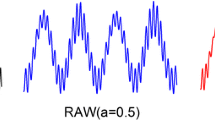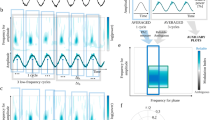Abstract
Cross-frequency phase-amplitude coupling (PAC) in neuronal oscillations network plays an important functional role in large scale neuronal communication and neuronal encoding. In the present study, a novel approach named permutation mutual information (PMI) was applied in measuring PAC. It is derived from the permutation entropy based on the mutual information theory, by which the mutual information of permutations of two time series can be evaluated. In order to verify the ability of PMI, a numerical test was performed by using both simulation data and experimental data. The performances of PMI were compared with that of two well-known methods, which were the mean vector length (MVL) and the modulation index (MI). It was found that the performance of PMI was similar to that of MI when measuring PAC intensity, but the coupling sensitivity of PMI was the highest among all these three approaches. Moreover, there was the lowest sensitivity in the MVL measurement, suggesting that MVL was a more conservative approach in detecting the existence of PAC. In addition, an ROC analysis showed that PMI performed better in measuring PAC compared to that of others. Furthermore, the experimental data, obtained from rats’ hippocampal CA3 regions, were analyzed by using the three approaches. The result was essentially in line with that of the simulation performances. In a word, the results suggest that PMI is a better choice for assessing PAC under the certain conditions.









Similar content being viewed by others
References
Aru J, Aru J, Priesemann V, Wibral M, Lana L, Pipa G et al (2015) Untangling cross-frequency coupling in neuroscience. Curr Opin Neurobiol 31:51–61
Axmacher N, Henseler MM, Jensen O, Weinreich I, Elger CE, Fell J (2010) Cross-frequency coupling supports multi-item working memory in the human hippocampus. Proc Natl Acad Sci USA 107(7):3228–3233
Bandt C, Pompe B (2002) Permutation entropy: a natural complexity measure for time series. Phys Rev Lett 88(17)
Canolty RT, Knight RT (2010) The functional role of cross-frequency coupling. Trends Cogn Sci 14(11):506–515
Canolty RT, Edwards E, Dalal SS, Soltani M, Nagarajan SS, Kirsch HE et al (2006) High gamma power is phase-locked to theta oscillations in human neocortex. Science 313(5793):1626–1628
Canolty RT, Cadieu CF, Kilian K, Knight RT, Carmena JM (2012) Multivariate phase-amplitude cross-frequency coupling in neurophysiological signals. IEEE Trans Biomed Eng 59(1):8–11
Cohen MX (2008) Assessing transient cross-frequency coupling in EEG data. J Neurosci Methods 168(2):494–499
Colgin LL, Denninger T, Fyhn M, Hafting T, Bonnevie T, Jensen O et al (2009) Frequency of gamma oscillations routes flow of information in the hippocampus. Nature 462(7271):353–357
Delorme A, Makeig S (eds) (2004) EEGLAB: an open source toolbox for analysis of single-trial EEG dynamics including independent component analysis. J Neurosci Methods 134:9–21
Dvorak D, Fenton AA (2014) Toward a proper estimation of phase-amplitude coupling in neural oscillations. J Neurosci Methods 225:42–56
Fawcett T (2006) An introduction to ROC analysis. Pattern Recogn Lett 27(8):861–874
Fell J, Axmacher N (2011) The role of phase synchronization in memory processes. Nat Rev Neurosci 12(2):105–118
Gerber EM, Sadeh B, Ward A, Knight RT, Deouell LY (2016) Non-sinusoidal activity can produce cross-frequency coupling in cortical signals in the absence of functional interaction between neural sources. PLoS ONE 11(12):e0167351
Handel B, Haarmeier T (2009) Cross-frequency coupling of brain oscillations indicates the success in visual motion discrimination. Neuroimage 45(3):1040–1046
Jensen O, Colgin L (2007) Cross-frequency coupling between neuronal oscillations. Trends Cogn Sci 11:267–269
Jensen O, Lisman JE (2005) Hippocampal sequence-encoding driven by a cortical multi-item working memory buffer. Trends Neurosci 28(2):67–72
Jiang H, Bahramisharif A, Gerven MAJV, Jensen O (2015) Measuring directionality between neuronal oscillations of different frequencies. Neuroimage 118(2848):456–457
Kopell N, Ermentrout GB, Whittington MA, Traub RD (2000) Gamma rhythms and beta rhythms have different synchronization properties. PNAS 97(4):1867–1872
Li X, Ouyang GX (2010) Estimating coupling direction between neuronal populations with permutation conditional mutual information. Neuroimage 52:497–507
Li Q, Zheng CG, Cheng N, Wang YY, Yin T, Zhang T (2016) Two generalized algorithms measuring phase–amplitude cross-frequency coupling in neuronal oscillations network. Cogn Neurodyn 10:235–243
Lisman J (2005) The theta/gamma discrete phase code occurring during the hippocampal phase precession may be a more general brain coding scheme. Hippocampus 15:913–922
Magri C, Whittingstall K, Singh V, Logothetis NK, Panzeri S (2009) A toolbox for the fast information analysis of multiple-site LFP, EEG and spike train recordings. BMC Neurosci 10(1):1–24
Mi XC, Cheng N, Zhang T (2014) Performance comparison of both gPDC and PCMI algorithms for measuring directionality of neural information flow. J Neurosci Methods 227:57–64
Morabito FC, Labate D, La Foresta F, Bramanti A, Morabito G, Palamara I (2012) Multivariate multi-scale permutation entropy for complexity analysis of Alzheimer’s disease EEG. Entropy 14(7):1186–1202. doi:10.3390/e14071186
Olivier D, Diego C, Friston KJ (2004) Evaluation of different measures of functional connectivity using a neural mass model. Neuroimage 21(2):659–673
Olofsen E, Sleigh JW, Dahan A (2008) Permutation entropy of the electroencephalogram: a measure of anaesthetic drug effect. Br J Anaesth 101(6):810–821
Onslow AC, Bogacz R, Jones MW (2011) Quantifying phase-amplitude coupling in neuronal network oscillations. Prog Biophys Mol Biol 105(1–2):49–57
Panzeri S, Senatore R, Montemurro MA, Petersen RS (2007) Correcting for the sampling bias problem in spike train information measures. J Neurophysiol 98(3):1064–1072
Papoulis A (1991) Probability, random variables, and stochastic processes. McGraw-Hill, New York
Penny WD, Duzel E, Miller KJ, Ojemann JG (2008) Testing for nested oscillation. J Neurosci Methods 174(1):50–61
Schutter DJLG, Knyazev GG (2012) Cross-frequency coupling of brain oscillations in studying motivation and emotion. Motiv Emotion 36(1):46–54
Swets JA (1996) Signal detection theory and ROC analysis in psychology and diagnostics. Lawrence Erlbaum Associates, Mahwah, pp 840–841
Tort AB, Kramer MA, Thorn C, Gibson DJ, Kubota Y, Graybiel AM et al (2008) Dynamic cross-frequency couplings of local field potential oscillations in rat striatum and hippocampus during performance of a T-maze task. Proc Natl Acad Sci USA 105(51):20517–20522
Tort AB, Komorowski RW, Manns JR, Kopell NJ, Eichenbaum H (2009) Theta-gamma coupling increases during the learning of item-context associations. Proc Natl Acad Sci USA 106(49):20942–20947
Tort ABL, Komorowski R, Eichenbaum H, Kopell N (2010) Measuring phase-amplitude coupling between neuronal oscillations of different frequencies. J Neurophysiol 104:1195–1210
Xu XX, Zheng CG, Zhang T (2013) Reduction in LFP cross-frequency coupling between theta and gamma rhythms associated with impaired STP and LTP in a rat model of brain ischemia. Front Comput Neurosci 7(27)
Xu XX, Liu CH, Li ZY, Zhang T (2015) Effects of hydrogen sulfide on modulation of theta–gamma coupling in hippocampus in vascular dementia rats. Brain Topogr 28:879–894
Zanin M, Zunino L, Rosso OA, Papo D (2012) Permutation entropy and its main biomedical and econophysics applications: a review. Entropy 14(8):1553–1577
Zheng C, Zhang T (2015) Synaptic plasticity related neural oscillations on hippocampus-prefrontal cortex pathway in depression. Neuroscience 292:170–180
Acknowledgements
This work was supported by grants from the National Natural Science Foundation of China (11232005, 31771148), 111 Project (B08011), the State Key Laboratory of Medicinal Chemical Biology and the Ph.D. Candidate Research Innovation Fund of Nankai University (63163004).
Author information
Authors and Affiliations
Corresponding author
Ethics declarations
Conflict of interest
There is not a conflict of interest for all authors.
Electronic supplementary material
Below is the link to the electronic supplementary material.
Rights and permissions
About this article
Cite this article
Cheng, N., Li, Q., Wang, S. et al. Permutation Mutual Information: A Novel Approach for Measuring Neuronal Phase-Amplitude Coupling. Brain Topogr 31, 186–201 (2018). https://doi.org/10.1007/s10548-017-0599-2
Received:
Accepted:
Published:
Issue Date:
DOI: https://doi.org/10.1007/s10548-017-0599-2




